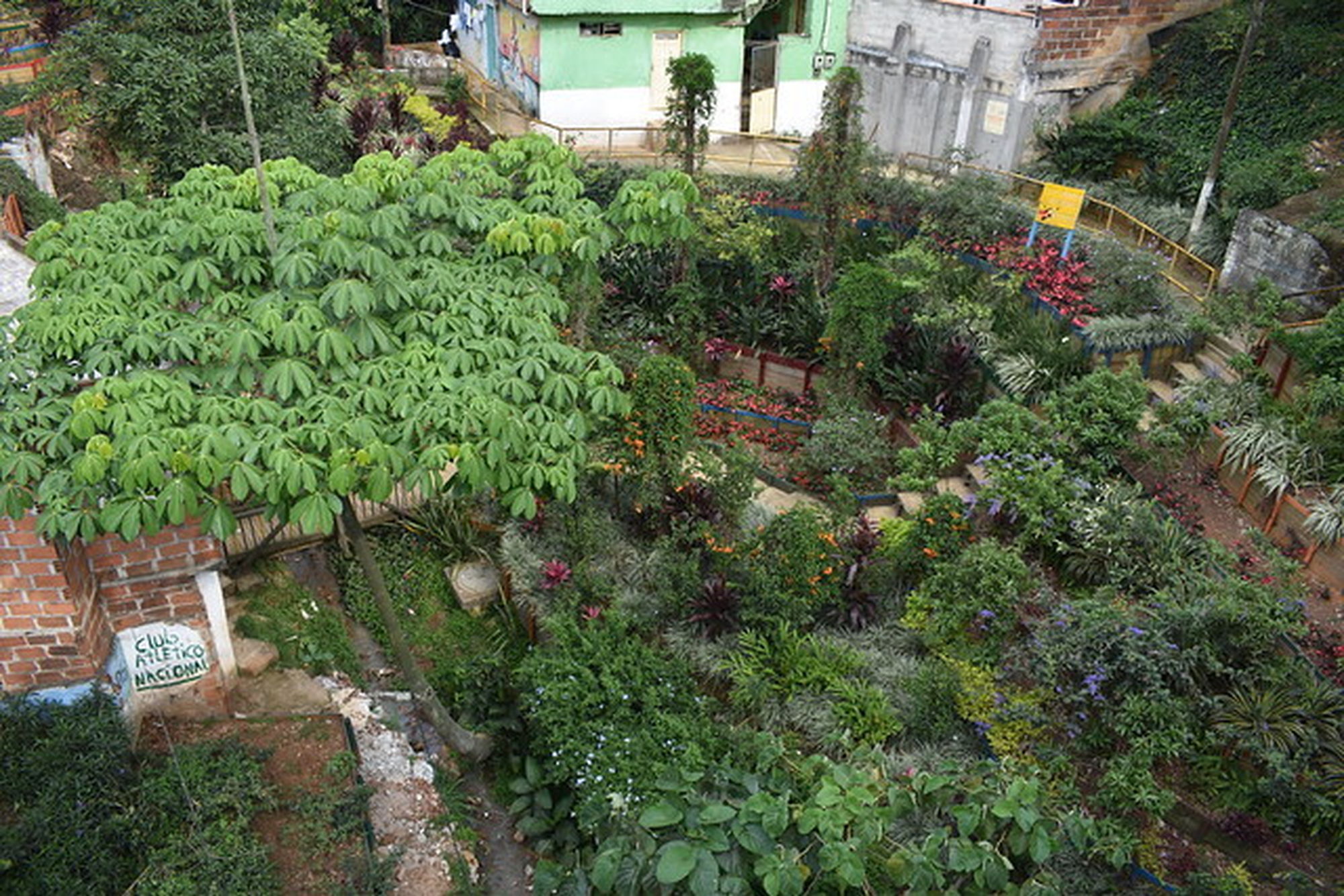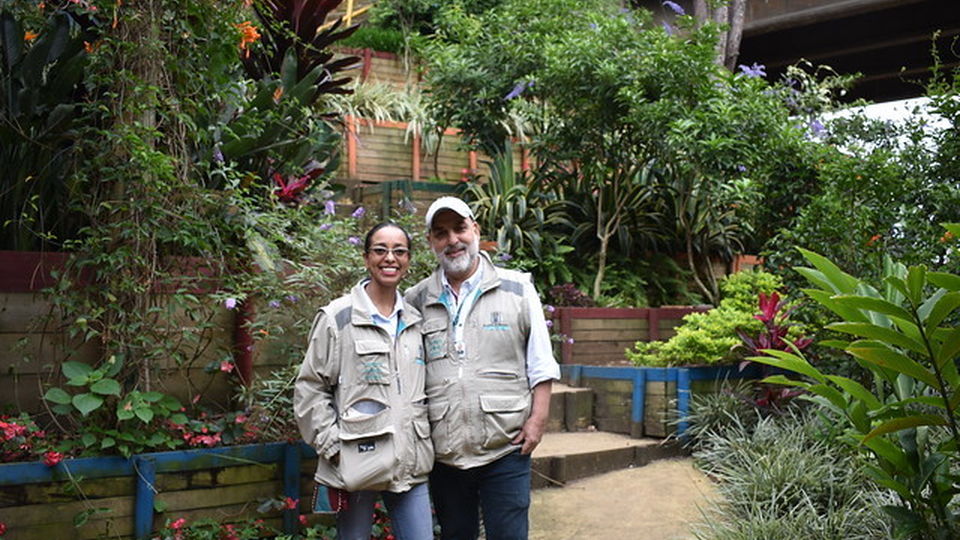
Medellín, Colombia’s second-largest city, shows us how we can both mitigate and adapt to climate change thanks to nature-based solutions.
Medellin’s 30 ‘Green Corridors’ have reduced temperatures and improved air quality and biodiversity
Colombia’s second-largest city, Medellin, has embraced nature as a cooling solution. Instead of turning up the air conditioning, which in turn leads to a massive surge in power demand and further contributes to global warming, Medellin has implemented the ‘Green Corridors’ project, transforming 18 roads and 12 waterways into lush, green havens of cool shade.
These Green Corridors have helped to reduce the urban “heat island” effect—when pollution and high population density turn cities into urban heat islands, with significantly higher temperatures than the surrounding rural areas. The introduction of 8,300 trees and 350,000 shrubs has reduced the surface temperature in Medellin by 2-3 ̊C and has also improved air quality and biodiversity.

Medellín is literally growing itself a cooler city
After suffering years of high crime and violence, Colombia’s second largest city, Medellín, faces a new threat – rising urban temperatures, driven by climate change. The city’s response has brought people together, by planting vegetation to create a better environment for everyone.
The Green Corridors project shades cyclists and pedestrians, cools built up areas and cleans the air along busy roads. The city’s botanical gardens train people from disadvantaged backgrounds to become city gardeners and planting technicians. Temperatures have fallen by two or three degrees Celsius in places, with bigger reductions expected in the future.
As global temperatures rise, the daily lives of many are becoming more uncomfortable and even dangerous, with heat waves a real and deadly threat. In cities, the problem is made worse by the urban “heat island” effect, where large areas of concrete and tarmac absorb the sun’s heat, pushing temperatures up even further.
The second most populous city in Colombia, Medellín has introduced an exciting urban greening programme called Green Corridors. The programme is boosting biodiversity and reducing the urban heat island effect. Through beautiful and functional greenery, the city is adapting to climate change and giving residents a better quality of life.
Medellín’s city authorities have improved the environment of the city by creating 30 huge green corridors – areas thick with vegetation – along 18 roads and 12 waterways. The project aims to create a more beautiful city, tackle the urban heat island effect, increase biodiversity and cut air pollution. Cooling is created by more shading, cuts to the heat radiated by solid surfaces such as a roads, and water evaporating from plants.
Since the programme started, the botanical gardens have trained 75 new gardeners. This has helped people who are most vulnerable, displaced by the armed conflict or from poorer rural communities to find work. The apprenticeship scheme gives them workplace training as well as a qualification.
Scroll down for beautiful video footage of Medellín’s Green Corridors.
Source: Ashden.org

How other cities around the world are adapting to soaring temperatures
Los Angeles’ white streets
By mid-century, Los Angeles could face 22 days of extreme heat – 35 ̊C and above – every year, according to a 2015 study. To beat the heat, the city has started painting its roads and pavements with a reflective white coating called CoolSeal.
Dark asphalt covering city roads bakes when temperatures rise, absorbing between 80-95% of the sun’s rays. White roads reflects the rays instead of absorbing them and can significantly lower temperatures. The CoolSeal coating can keep roads up to 5.55°C cooler – a vital difference as urban temperatures continue to rise.
Paris’ ‘cool islands’
France recorded its hottest day ever in July, with temperatures in Paris reaching a scorching 42.6°C. After a heat wave in 2003 contributed to tens of thousands of premature deaths, Paris took important heat mitigation measures, including the installation of over 900 ‘cool islands.’ These cool islands include shaded parks, air-conditioned libraries, and outdoor pools where people can escape when it is very hot.
A mobile application, that uses real-time satellite data to estimate the temperature, humidity and discomfort index across the city, helps to quickly locate the nearest ‘cool island’ for the user and the freshest route to get there.
New York’s reflective roofs
Faced with rising heat, New York painted over 9.2 million square feet of rooftops white, to offset greenhouse gas emissions and keep buildings cool. The CoolRoofs project is part of New York’s goal to cut carbon emissions by 80% by 2050.
The white reflective paint significantly reduces temperatures inside the building and helps lower air conditioning costs, according to Small Business Services, the company that runs the project. White roofs reduce cooling costs by 10-30% and can lower surface temperatures by up to 3°C, according to a 2014 study.
Mexico City‘s vertical gardens
As part of the Via Verde Project this citizen-led initiative aims to fight pollution, help beautify the city and decrease motorists’ stress levels. The Via Verde project in Mexico City aims to turn 1,000 highway pillars into vertical gardens. A variety of plants are placed inside "pockets" of felt to make the city greener and its air cleaner.
A hydroponic system collects rainwater to cover its needs and each garden is equipped with sensors to allow remote monitoring.
Source: GCA.org
6 THINGS YOU CAN DO TO PREVENT CLIMATE CHANGE
Climate change has already begun to impact our planet in more ways than we can think. Temperatures continue to rise throughout the planet and we are experiencing changes in precipitation patterns as we have never seen before. The main cause of these catastrophic effects on our planet is pollution. Fortunately, there are always things that we can do to fight against climate change. Saving the environment starts with us and it is our responsibility to act against these terrible changes to preserve the planet for future generations.